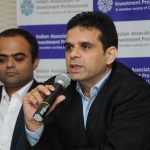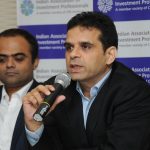- January 22, 2016
- Posted by:
- Category:BLOG, India Investment Conference, Mumbai
Speaker: Manoj Pradhan, Senior Economist, Global Economics Team, Morgan Stanley
Moderated by: Jayesh Gandhi, CFA, President IAIP and Senior Portfolio Manager Birla Sun Life AMC
Contributed by: Kunal Sabnis, CFA, Chair Communication, IAIP and Analyst VEC Investments
Since the 1980s, there began a multi-decade trend of abundant growth, lower inflation & wages, and increasing inequality in the world. It was led by baby-boomers getting added to the working population in 1970s and Russia and China doubling global work force in 1990s. This led to an increase in total production and put disinflationary pressure on global economy. China became the production powerhouse of the world, but Chinese financial markets were not integrated with the world. This culminated in a fall in investments as a percentage of savings in developed markets, lowering real interest rates. China kept its domestic real interest rates low, boosting domestic investment and leading to unequal investments in the world.
Wages were set by China hence developed markets wages kept falling towards the new equilibrium. As capex fell and labour force stayed stable, capital to-labour ratio fell, reducing productivity. Economists such as Larry Summers, Rogoff and Gordon expect secular stagnation over few years due to excess capacity leading to output gap, debt super cycle de-leveraging and decline in population growth. Manoj expects a divergence since excess capacity is an issue only with China and Korea unlike US, EU and Japan. Also debt levels in most emerging markets are low, and they can cut real interest rates to boost production.
Since global interest rates are set by US and EU, Manoj believes that real interest rates would start inching higher and so will inflation. Wages will rise once again as ageing population will reduce workforce. Corporates will replace labour costs with capital, increasing productivity. This will reduce global inequality. Rising real interest rates would also push asset prices lower.
While taking audience’s questions Manoj opined that every economy, which has escaped poverty, has accumulated capital when population growth was strong. India will benefit at the cost of China since Chinese consumption would fall, with a fall in capex, similar to Japan. India will have abundant low hanging fruit in the direction of productivity and prosperity.
- KS
PS:
For the complete coverage of #IndiaInvConf (for India Investment Conference 2016) kindly click on the links to the posts on the WordPress or search under the tab “India Investment Conference”:
#IndiaInvConf – India Investment Conference: Strategies For An Emerging Environment
#IndiaInvConf – The Aspirational Investors: Investing In The Pursuit Of Wealth And Happiness
#IndiaInvConf – The Corporate Life Cycle – Lessons For Investors
#IndiaInvConf – Multi-Asset Investing: A Practitioner’s Framework
You could also read tweets by typing #IndiaInvConf, @iaipcfa, @CFAIndia, @CFAAsia, @CFAInstitute




















[…] #IndiaInvConf – Global Economic Outlook: Why the Next 30 Years Will Look Nothing Like The Last… […]
[…] #IndiaInvConf – Global Economic Outlook: Why the Next 30 Years Will Look Nothing Like The Last… […]
[…] #IndiaInvConf – Global Economic Outlook: Why the Next 30 Years Will Look Nothing Like The Last… […]
[…] #IndiaInvConf – Global Economic Outlook: Why the Next 30 Years Will Look Nothing Like The Last… […]
[…] But from Pradhan’s perspective, secular stagnation is an unlikely explanation. He expects that productivity will recover and real interest rates will rise along with inflation. The forces at work will not only reverse current trends, but ensure that the next 30 years will look nothing like the last 30. […]